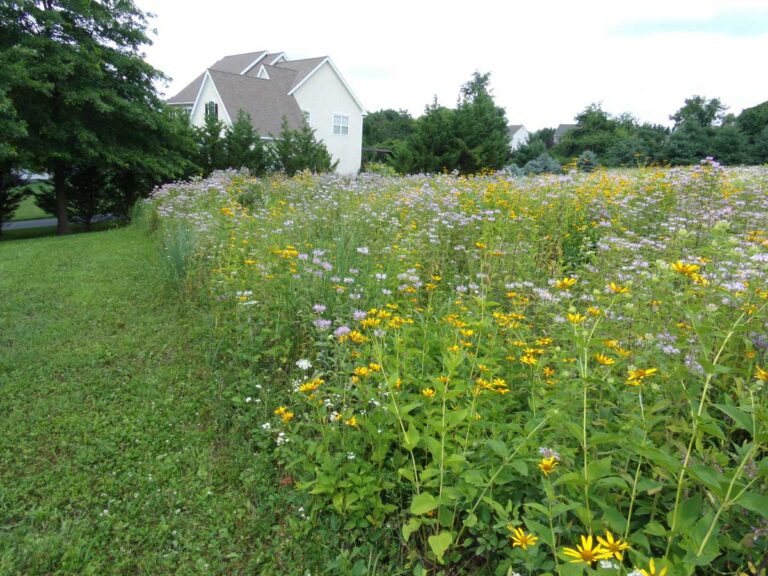A garden full of beautiful wildflowers is a critical source of nutrition for pollinators, but it isn’t the only thing they need to thrive. Bees, butterflies, hummingbirds, and other beneficial insects also require nesting sites, shelter, and safe, pesticide-free spaces to feed and reproduce.
If you’re serious about attracting pollinators, you’ll need a landscape designed from the ground up with them in mind.
This guide will walk you through the fundamentals of how to attract pollinators through smart landscaping practices, including:
- Choosing native plants that support pollinators through every season
- Meeting the nutritional needs of different species
- Creating nesting sites and protective cover
- Maintaining your garden without disrupting pollinator life cycles
- Adding water, perches, and other simple enhancements
With the right approach, your garden can become a vital resource for local biodiversity. Let’s start with plant selection.
Plant Selection to Attract Pollinators
The backbone of any pollinator-friendly landscape is plant diversity. Specifically, you want native wildflower species that provide pollen, nectar, and habitat support across the growing season. That means choosing plants that have evolved alongside local bees, butterflies, moths, birds, and beneficial insects.
Meeting the Nutritional Needs of Pollinators
Pollinators have different dietary requirements at different life stages. Bees need both nectar (carbohydrates) and pollen (protein), which they gather from diverse floral sources. Butterflies rely on nectar as adults but require specific host plants for their larvae (e.g., milkweed for monarchs, spicebush for swallowtails). Hummingbirds feed primarily on nectar but also rely heavily on insects and spiders for protein, especially during nesting season.
To meet these needs:
- Choose a variety of flower types—open, shallow flowers for small native bees and hoverflies; tubular blooms for butterflies, bumble bees, and hummingbirds.
- Ensure a season-round bloom by choosing a range of flowers that bloom from spring to fall.
- Prioritize insect-rich plants like goldenrod and oak species that support caterpillars and beetles, which are a critical food for baby birds and adult hummingbirds.
By planning for both diversity and seasonality, you build a nutrient-dense landscape that doesn’t just attract pollinators but sustains them all year.
Season-Long Bloom: What to Plant and When
A successful pollinator garden offers uninterrupted foraging from early spring to late fall. Clusters of flowers are easier for pollinators to locate and more efficient to feed on. Use a mix of heights, bloom shapes, and colors to support a wide variety of species.
Early Season:
- Lanceleaf Coreopsis (Coreopsis lanceolata)
- Eastern Columbine (Aquilegia canadensis)
- Tall White Beardtongue (Penstemon digitalis)
Mid-Season
- Wild bergamot (Monarda fistulosa)
- Butterfly milkweed (Asclepias tuberosa)
- Purple coneflower (Echinacea purpurea)
- Mountain mint (Pycnanthemum spp.)
Late Season
- Asters (Aster spp.)
- Goldenrods (Solidago spp.)
To guarantee a healthy mix of native wildflowers, consider using a seed mix prepared by the experts at Ernst.
Creating Nesting and Shelter to Attract Pollinators to Your Garden
If your landscape doesn’t provide places to nest, hide, or overwinter, many pollinators simply won’t stick around. Native bees, butterflies, moths, hummingbirds, and beneficial insects all need specific types of shelter to complete their life cycles.
Nesting Sites for Native Bees
Roughly 70% of native bee species in the Northeast are ground-nesters. They require bare, undisturbed soil in sunny areas. That means avoiding mulch, turf, or landscaping fabric. Even small patches of open, well-drained ground can support dozens of bee nests. The remaining ~30% are cavity-nesters, using hollow stems, beetle tunnels, or plant debris.
To support bee nesting:
- Leave bare patches of soil in out-of-the-way sunny spots.
- Some open space is essential. Avoid mulching every square foot.
- Mow close to the ground, 1″ – 2″. Mow most of the meadow, leaving 1/3 of the area unmowed.
Shelter for Butterflies, Birds, and Others
Many butterflies and moths overwinter in leaf litter, bark crevices, or plant stems. Removing these features in fall or early spring can destroy eggs, caterpillars, or chrysalises before they emerge.
- Leave fallen leaves under shrubs and in garden beds through winter.
- Maintain a small brush pile or thicket for cover.
- On the outside of your meadow (not in it), a cluster of woody plants and native grasses can provide both summer shelter and winter refuge.
Hummingbirds, meanwhile, nest in trees or shrubs and use plant down from milkweed and thistle to line their nests. Even spider webs, often seen as a nuisance, are used to hold nests together.
By building your landscape with multiple habitat layers like soil, stems, shrubs, and trees, you give pollinators the structural diversity they need to nest, roost, and reproduce safely.
Maintaining a Landscape that Attracts Pollinators
A pollinator-friendly garden isn’t just about what you plant, but also about how you maintain it. Routine practices like mowing, mulching, or trimming can either support or disrupt pollinator activity depending on when and how they’re done.
Mow Less, Grow More
To support pollinators and native growth, we recommend avoiding mowing entirely during the growing season. Mowing reduces flower availability and can destroy habitat for ground-nesting bees and butterflies.
We recommend mowing in late fall or early spring, when most insects have completed their life cycles or are still dormant in sheltered areas. If you’re managing a larger meadow or wildflower area, follow a rotational mowing schedule: cutting only a portion at a time so pollinators always have access to forage and cover.
Rethink Fall and Spring Cleanup
Many bees and butterflies overwinter in hollow stems or leaf litter and emerge when the weather warms. To avoid destroying critical shelter in the cold, it’s best to delay your spring cleanup until temperatures are consistently above 50°F.
Leave the leaves, at least in garden beds or under shrubs. They can help insulate overwintering pollinators and serve as habitat for butterfly pupae and moth cocoons.
Leave up to 1/3 of the meadow unmowed the first season, and rotate the mowed area. These serve as nesting sites for stem-nesting bees.
Avoid Pesticides (Even Organic Ones)
All insecticides, including “natural” or organic formulas, are harmful to pollinators.
A diverse, native plant-based landscape naturally attracts predatory insects and birds that help keep pest populations in check.
Water and Additional Features that Help Attract Pollinators
Water, shelter from the elements, and places to rest can significantly increase your garden’s appeal while making it even more attractive to pollinators.
Provide Water Sources
Set out a shallow dish filled with clean water and add pebbles or flat stones for landing spots. Bees will appreciate this for both drinking and cooling off.
Mud puddling areas are essential for butterflies and some bees seeking minerals. You can create these by mixing damp soil with a pinch of salt.
Hummingbirds, in particular, prefer fine mist or gently moving water. You might consider adding a mister, dripper, or light fountain for them.
Include Resting and Perching Areas
Bees and butterflies both enjoy basking on warm surfaces. Rocks or other flat surfaces are perfect for this and can add depth and visual appeal to your garden.
On the outside of your meadow, small shrubs or brushy patches can help insects escape wind and rain. Hummingbirds also need thin branches or dead twigs to perch on and help them guard food sources.
As a finishing touch, just a few of these intentional features on the periphery can turn a good pollinator garden into a thriving, full-service habitat.
Ernst Can Help You Create Serene Landscapes that Attract Pollinators
By planting a diverse mix of native species, creating habitat for nesting and overwintering, reducing harmful maintenance practices, and offering water and shelter, you turn your yard into a living ecosystem that supports bees, butterflies, birds, and more.
Each element of your landscape, from bloom timing to brush piles, plays a role in sustaining the pollinators we all rely on for food production, ecological balance, and natural beauty. And with so much misinformation out there, building your garden on science-backed practices is one of the most impactful things you can do.
If you have questions about specific plant pairings, seed mixes, or how to tailor your site to local conditions, the experts at Ernst Conservation Seeds are here to help. Whether you’re planting a small backyard or restoring acres of habitat, Ernst can help you build a pollinator landscape that actually works.

